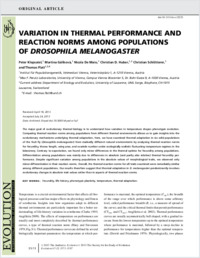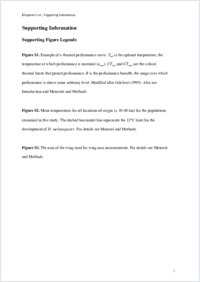Variation in thermal performance and reaction norms among populations of Drosophila melanogaster
- Klepsatel, Peter Institut für Populationsgenetik
- Gáliková, Martina Institut für Populationsgenetik
- De Maio, Nicola Institut für Populationsgenetik
- Huber, Christian D. Institut für Populationsgenetik
- Schlötterer, Christian Institut für Populationsgenetik
- Flatt, Thomas Institut für Populationsgenetik
-
2013
Published in:
- Evolution. - 2013, vol. 67, no. 12, p. 3573–3587
English
The major goal of evolutionary thermal biology is to understand how variation in temperature shapes phenotypic evolution. Comparing thermal reaction norms among populations from different thermal environments allows us to gain insights into the evolutionary mechanisms underlying thermal adaptation. Here, we have examined thermal adaptation in six wild populations of the fruit fly (Drosophila melanogaster) from markedly different natural environments by analyzing thermal reaction norms for fecundity, thorax length, wing area, and ovariole number under ecologically realistic fluctuating temperature regimes in the laboratory. Contrary to expectation, we found only minor differences in the thermal optima for fecundity among populations. Differentiation among populations was mainly due to differences in absolute (and partly also relative) thermal fecundity performance. Despite significant variation among populations in the absolute values of morphological traits, we observed only minor differentiation in their reaction norms. Overall, the thermal reaction norms for all traits examined were remarkably similar among different populations. Our results therefore suggest that thermal adaptation in D. melanogaster predominantly involves evolutionary changes in absolute trait values rather than in aspects of thermal reaction norms.
- Faculty
- Faculté des sciences et de médecine
- Department
- Département de Biologie
- Language
-
- English
- Classification
- Biological sciences
- License
-
License undefined
- Identifiers
-
- RERO DOC 324304
- DOI 10.1111/evo.12221
- Persistent URL
- https://folia.unifr.ch/unifr/documents/307552
Other files
Statistics
Document views: 140
File downloads:
- pdf: 192
- Supplementary material: 124

